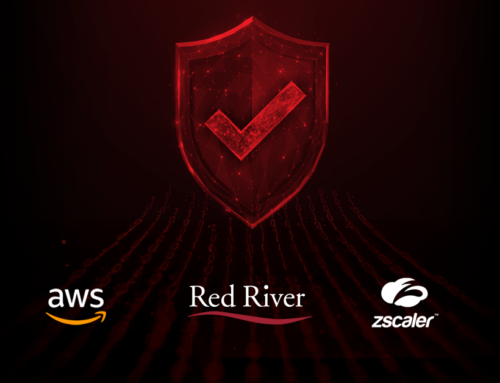
GRC In Cyber Security: What You Need to Know
The complexities of developing a determined cyber security posture and meeting government data protection mandates have morphed into a full-time occupation. It wasn’t that long ago that updating firewalls and anti-virus software applications seemed to repel garden variety hackers. Today’s advanced persistent threats find ways to overcome innovative protections.
As lawmakers and bureaucrats write new policies, it feels like business professionals are stuck between a rock and a hard place. Fortunately, Red River helps growing companies adapt by integrating solutions such as governance, risk and compliance cyber security measures.
What Does Governance, Risk and Compliance Mean for Cyber Security?
The phrase “Governance, Risk and Compliance” is a relatively new way of approaching people, technology and the processes that help organizations generate profits and achieve their goals. Reportedly coined by the non-profit think tank Open Compliance and Ethics Group in 2027, GRC is a way of doing business that involves following ethical guidelines, communicating more effectively, and operating more efficiently. A GRC cyber security approach brings together a variety of defined measures under the umbrella of coordinating its three core principles.
Governance Policies
An organization’s governance policies are typically agreed-upon rules that stakeholders follow when making corporate decisions. They are usually designed to make internal processes more efficient and support strong relationships among interested parties. Governance policies can also protect the interests of shareholders and decision-makers from liability. These are key elements of governance policies.
- Accountability and Responsibility
- Transparency and Forthrightness
- Conflict of Interest Acknowledgment
While governance tends to be viewed as an overarching approach to operating an enterprise, its relationship to cyber security is essential. Company leaders are tasked with crafting cyber security policies to manage critical processes that set the tone for risk management and regulatory compliance.
In other words, cybersecurity governance is the thought leadership behind the methods used to minimize threats, harden corporate defenses and ensure the standards and practices used to protect data meet regulatory guidelines.
Risk Management
The notion of risk management has been around for more than 100 years. The concept became a formally studied discipline during the 1950s, long before the World Wide Web was invented by Tim Berners-Lee in 1989. The process of mitigating threats by identifying, assessing and then taking determined steps to exercise measured control over threats and risk management is an approach that is tailor-made for cyber security experts.
That’s largely because risk management does not necessarily operate under the assumption that total control can be achieved. Instead, the severity of wide-reaching threats is reviewed, and responses are implemented based on risk reduction. These rank among the basic tenets of risk management.
- Identifying Risks
- Assessing Threat Levels
- Creating Proactive Solutions
- Ongoing Monitoring
In many ways, risk management is about finding ways to avoid setbacks and minimize potential harm. This concept is akin to today’s cybersecurity landscape, in which hackers constantly devise ways to circumvent data privacy defenses and penetrate corporate networks.
Compliance
Compliance may be the aspect of GRC that business professionals have the least control over. Regulatory compliance is primarily driven by state and federal lawmakers, as well as agencies tasked with drilling down on emerging threats to data privacy, as well as dangers to national security. The head-spinning number of regulations an organization must follow to remain compliant has overwhelmed operations that once relied on a small IT department. These rank among the more ubiquitous data protection regulations government agencies require organizations to follow.
- California Consumer Privacy Act
- Cybersecurity Maturity Model Certification (CMMC)
- Federal Information Security Management Act
- Health Insurance Portability and Accountability Act (HIPAA)
- Payment Card Industry Data Security Standard
- The EU’s General Data Protection Regulation
Maintaining regulatory compliance has become an uphill climb for American companies due to the fact that the government employs a patchwork approach. Without a single, over-arching set of rules, enterprises find themselves getting fined and licenses suspended despite efforts to keep pace with changing mandates. The use of GRC in cyber security helps mitigate the risk of businesses having government contracts yanked or getting sidelined.
What is GRC in Cyber Security?

Industry leaders are not necessarily technology experts, nor do many thought leaders immerse themselves in corporate policymaking. Corporate movers and shakers use specialized knowledge to create and implement an actionable vision for their respective endeavors. While important to organizational success, spending too much energy on issues such as GRC in cyber security can distract from goal achievement. That being said, a straightforward way to understand GRC cyber security may be to think of it as a three-pronged tool. Each element works seamlessly with the others in a unique fashion to shore up the wide range of challenges that could undermine profit-driving efforts.
By bringing in a team of corporate cybersecurity experts to meet with department heads, pertinent issues can be discussed that solidify your data protection and compliance posture. These are typical GRC steps needed to create a successful three-pronged mechanism.
- Identify Applicable Regulations: The digital information in each industry is regulated by specific rules and oversight agencies. For instance, U.S. Department of Defense contractors must adhere to the recent CMMC. Healthcare organizations are required to follow HIPAA to the letter. These and others are starting points for GRC cyber security discussions.
- Conduct a Risk Assessment: It’s essential to have a highly defined understanding of your organization’s cyber security strengths and weaknesses. Military contractors who have adopted the mandated CMMC compliance level are learning that enhanced regulations are already in the pipeline. Risk assessments allow cyber security professionals and leadership teams to come together and understand areas that do or could fall short of regulatory compliance.
- Craft Governance Policies: The importance of aligning regulatory mandates with internal operations cannot be understated. Knowing where policies, best practices and data security intersect provides an opportunity to map out ways to harden your attack surface, improve organizational efficiency, further the company’s interests and stay in the good graces of state, federal and international agencies.
When people outside the cyber security and managed IT fields come across the term GRC, they tend to understand it in a linear fashion. In other words, you start with governance, move on to risk and find a way to comply with data protection policies. Truth be told, the process is organic and ongoing, with companies circling back to make changes as additional regulations are promulgated, threat actors pose new data risks and governance policies require updates.
What is the True Cost of Non-Compliance?
When budgets are tight, it’s not unusual for companies to look for ways to reduce the cost of managed IT and cyber security. On the one hand, these areas appear to be logical cost-cutting options because they do not directly relate to profitability. At first blush, that idea may seem to hold water. However, the risk of non-compliance is far greater than any short-term savings.
A recent Forbes article noted that Morgan Stanley was the subject of a pair of lawsuits due to data breaches. After further review, the United States Office of the Comptroller of the Currency issued a $60 million penalty for what boils down to alleged non-compliance. Two years later, the nightmare was not over for Morgan Stanley after the Securities and Exchange Commission slapped the corporation with an additional $35 million penalty for “data security lapses.”
Data breaches are too often the result of subpar cyber security that doesn’t meet regulatory standards. When hackers infiltrate business networks, the average loss in 2023 hovered around $9.48 million. Needless to say, GRC cyber security strategies are far less expensive.
While the quantifiable financial losses are staggering, companies and their leadership teams also suffer soiled reputations. Customers, clients, vendors and others in your orbit will be disinclined to do business with your brand because they fear digital information getting exposed. Hackers rarely stop with one organization. They will leverage confidential information against others to enrich themselves. It’s not unusual for companies to shutter following a major data breach.
What are the Benefits of GRC in Cyber Security?
From a financial and longevity perspective, the key benefits of GRC in cyber security revolve around not sustaining debilitating losses. That being said, the benefits of integrating a GRC plan of action extend beyond data protection. These are ways a governance, risk and compliance strategy benefits organizations in every sector.
Organizational Efficiency Improvement: Adhering to the data protection regulations typically helps streamline redundancies. Eliminating unnecessary operational overlaps for the sake of GRC cyber security also makes your company more efficient. From reducing the expenses of SaaS licenses to duplicate tasks, GRC policies help trim the fat.
- Reduce Liability Insurance Costs: Cyber security insurance policies have become fundamental to doing business. Like auto, home and premises coverage, premiums are largely based on risk. Demonstrating regulatory compliance — coupled with a written GRC cyber security policy — can help reduce the cost of this business expense.
- Elevate Corporate Image: GRC cyber security does not need to be a purely internal business facet. Companies and customers that interact with your brand are likely to feel a sense of safety knowing you have gone the extra mile to protect their personal identity information and corporate data. Marketing the fact you have invested in GRC cyber security can attract new business.
- Greater Resilience: Organizations that are compliant are more resilient to changing regulations, as they already have systems in place to meet regulatory demands. This helps organizations better plan for future change, promoting greater business continuity.
Companies that leverage GRC cyber security policies also set themselves up for greater resiliency. Sophisticated cyber security criminals will continue to find workarounds and twist new technologies for bad ends. As they present a greater threat to your digital assets, your GRC cyber security program can be quickly altered to stave off potential attacks. This, in turn, allows you to stay ahead of regulatory demands that sometimes slow-moving bureaucracies roll out after the fact. The essential point is that governance, risk and compliance cyber security measures position your company for success.
Commonly Adopted GRC Tools and Cyber Security Measures
There are a variety of GRC tools companies can onboard that suit their unique industries, goals and networks. Software packages help organizations manage their governance policies, assess and identify risks, exercise better control and meet new regulatory directives. These include auditing software and applications that allow you to oversee multiple cloud platforms. In terms of cyber security approaches, these rank among the tried-and-true ways to minimize risk and maintain compliance.
Zero Trust Architecture
The fundamental idea behind zero trust cyber security is that it assumes a data breach will occur at some juncture. While every effort will be made to deter and defend against an incursion, zero trust deals hackers a mighty setback even if they manage to slip past defenses. Each user profile has established limitations regarding the programs, files and assets that can be used. Should a hacker learn someone’s username and password, they cannot pilfer off anything beyond the profile’s access. Meanwhile, any attempt to do so triggers a threat alert and immediate response. The Department of Defense plans to mandate zero trust cyber security.
Multi-Factor Authentication
Considered one of the simplest and most effective cyber security deterrents, multi-factor authentication requires network users to enter a secondary code before access to your business network is granted. A code is sent to a secondary communication platform or device that is not under the control of a hacker. Cyber criminals continue to be severely hampered by outfits that use this simple and effective approach that many regulations require. Other options companies adopt include the following.
- Application and Workload Security
- Endpoint Device Security
- Extended Detection and Response
Pivoting to a GRC cyber security position may come with a few challenges. Complex regulations can make the transition difficult. Manual processes and limited company resources can also be something of a hurdle. The good news is that managed IT firms with GRC cyber security expertise offer scalable solutions.
Implement GRC Cyber Security with the Help of Red River
At Red River, we work with organizations and agencies to craft cybersecurity solutions that detect, deter and expel threat actors. If you are interested in taking your data security and compliance to the next level, contact us today. Let’s get the process started.

written by
Corrin Jones
Corrin Jones is the Director of Digital Demand Generation. With over ten years of experience, she specializes in creating content and executing campaigns to drive growth and revenue. Connect with Corrin on LinkedIn.




